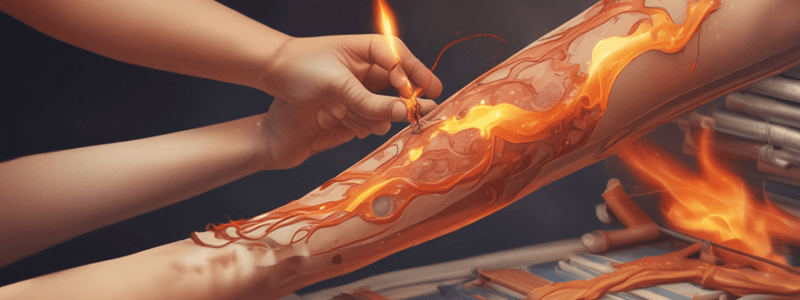Podcast
Questions and Answers
What is the primary goal of splinting in the C-rehabilitation phase?
What is the primary goal of splinting in the C-rehabilitation phase?
- To achieve normal ROM
- To protect anatomical structures
- To restore function and cosmoses
- To prevent deformity and maintain natural body contours (correct)
What is the primary purpose of applying splints in burn treatment?
What is the primary purpose of applying splints in burn treatment?
- To enhance the patient's cosmetic appearance
- To accelerate the wound healing process
- To replace traditional burn treatment methods
- To support burned extremities and maintain joint position (correct)
What is a characteristic of thermoplastic splints?
What is a characteristic of thermoplastic splints?
- They are only used in chronic burn cases
- They are non-toxic and absorbent
- They are heavy and expensive
- They can be remodeled according to their response to temperature (correct)
What is the purpose of splinting in the D-reconstructive phase?
What is the purpose of splinting in the D-reconstructive phase?
What is the primary consequence of a splint that is too tight?
What is the primary consequence of a splint that is too tight?
When is splinting required in the acute phase of burn injury?
When is splinting required in the acute phase of burn injury?
What is the primary goal of securing a splint with dressings or straps?
What is the primary goal of securing a splint with dressings or straps?
Why is it necessary to splint the joint in function position?
Why is it necessary to splint the joint in function position?
What should be monitored when splints are molded directly to the site?
What should be monitored when splints are molded directly to the site?
Why should a splint avoid direct contact with a bony prominence?
Why should a splint avoid direct contact with a bony prominence?
What is a consideration when using splints in the wound healing phase?
What is a consideration when using splints in the wound healing phase?
What is the significance of splinting techniques in burn treatment?
What is the significance of splinting techniques in burn treatment?
What is the primary reason for removing a splint that protects an exposed joint or tendon?
What is the primary reason for removing a splint that protects an exposed joint or tendon?
What is the purpose of splinting in the preservation of skin graft integrity?
What is the purpose of splinting in the preservation of skin graft integrity?
What is a characteristic of splints in general?
What is a characteristic of splints in general?
Why is daily checking and re-evaluation of a splint important?
Why is daily checking and re-evaluation of a splint important?
What should be done to prevent tendon rupture?
What should be done to prevent tendon rupture?
What should be done to a splint every time it is removed for wound care or exercise?
What should be done to a splint every time it is removed for wound care or exercise?
Why are thermoplastic splints preferred over traditional materials?
Why are thermoplastic splints preferred over traditional materials?
Why is it necessary to revise splints?
Why is it necessary to revise splints?
What is the purpose of combining sustained stretch and pressure with serial splinting?
What is the purpose of combining sustained stretch and pressure with serial splinting?
What type of splinting is useful during the early inflammatory stage of tissue healing?
What type of splinting is useful during the early inflammatory stage of tissue healing?
What is the primary focus of burn treatment?
What is the primary focus of burn treatment?
When is the use of both dynamic and serial static splints indicated?
When is the use of both dynamic and serial static splints indicated?
Flashcards are hidden until you start studying
Study Notes
Splinting Techniques for Burn Patients
- A splint is an external device that maintains joints in optimal length and corrects deformities.
- Splints are made of various materials, including thermoplastic, which can be remodeled according to temperature response.
Characteristics of Splints
- Non-toxic
- Lightweight
- Made from non-absorbent material
- Padded over bony prominence
- Easy to shape
- Firm enough
- Fabricated from inexpensive material
Significance of Splinting Techniques
- Preserves functional outcomes in combination with different treatments
- Important in preventing deformities, loss of Range of Motion (R.O.M), and disruption of joint integrity
Uses of Splints in Burn Treatment
- Acute phase: immobilizes and provides support to affected body parts
- Wound healing phase: prevents contracture and disruption of newly grafted skin
- Rehabilitation phase: reduces contracture, prevents deformity, and maintains natural body contours
- Reconstructive phase: restores function and cosmesis after contracture release or reconstructive procedures
Splinting Indications
- Protection of anatomical structures: stabilizes joints, eliminates external forces, and maintains tendon position
- Preservation of skin graft integrity: prohibits motion of joints near or under grafted areas
- Restoration of function: provides sustained stretch and pressure to maintain gained R.O.M
Requirements for All Splints
- Proper fit: not too loose or too tight
- Secure application: not too loose or too tight
- Avoidance of pressure over bony prominence
- Periodic removal: for wound care and to avoid joint stiffness
- Daily checking and re-evaluation: for changes in edema, dressings, or patient status
- Cleansing with each re-application: to prevent wound contamination
Types of Splints
- Static splints: useful during early inflammatory stage
- Dynamic splints: useful during proliferative stage of tissue healing
Studying That Suits You
Use AI to generate personalized quizzes and flashcards to suit your learning preferences.




